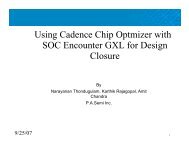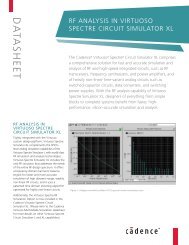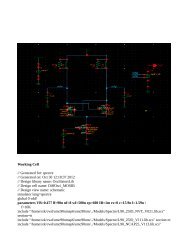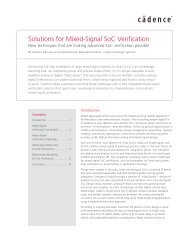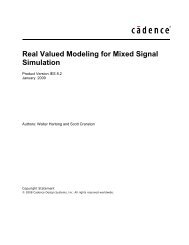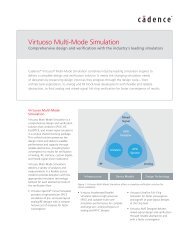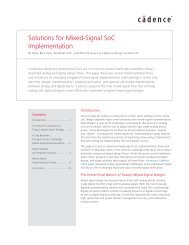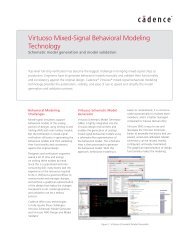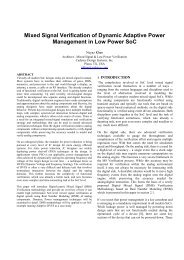An Assura geometry extraction and Spectre re-simulation flow to ...
An Assura geometry extraction and Spectre re-simulation flow to ...
An Assura geometry extraction and Spectre re-simulation flow to ...
You also want an ePaper? Increase the reach of your titles
YUMPU automatically turns print PDFs into web optimized ePapers that Google loves.
<strong>An</strong> <strong>Assura</strong> <strong>geometry</strong> <strong>extraction</strong> <strong>and</strong> <strong>Spect<strong>re</strong></strong> <strong>re</strong>-<strong>simulation</strong> <strong>flow</strong><br />
<strong>to</strong> simulate<br />
Shallow T<strong>re</strong>nch Isolation (STI) st<strong>re</strong>ss effects<br />
in analogue circuits<br />
Bernd Fischer<br />
Xignal Technologies AG, Germany<br />
CDNLive! EMEA Nice, France<br />
25 – 27 June 2006<br />
Xignal Technologies AG develops <strong>and</strong> markets mixed-signal ICs that enable new system<br />
architectu<strong>re</strong>s through significant improvements in performance <strong>and</strong> in power consumption.<br />
Xignal Technologies AG<br />
1
Abstract<br />
For CMOS technologies below 0.25µm Shallow T<strong>re</strong>nch Isolation (STI) has become the st<strong>and</strong>ard<br />
device isolation scheme.<br />
Despite its advantages, STI applies mechanical st<strong>re</strong>ss <strong>to</strong> the MOS transis<strong>to</strong>r changing its<br />
electrical device characteristic. As the st<strong>re</strong>ss depends on local layout geometries, the st<strong>re</strong>ss has<br />
<strong>to</strong> be evaluated for each individual device. The bsim3v3 model has been enhanced <strong>and</strong> new<br />
instance parameters <strong>and</strong> equations we<strong>re</strong> added <strong>to</strong> the model <strong>to</strong> cover this st<strong>re</strong>ss effects.<br />
This p<strong>re</strong>sentation shows an approach how STI st<strong>re</strong>ss effects can be accounted for. The<br />
p<strong>re</strong>sented method is based on an <strong>Assura</strong> <strong>geometry</strong> <strong>extraction</strong> <strong>and</strong> <strong>Spect<strong>re</strong></strong> <strong>re</strong>-<strong>simulation</strong> <strong>flow</strong>. For<br />
that the MOS transis<strong>to</strong>rs Component Description Format (CDF) we<strong>re</strong> modified <strong>and</strong> additional<br />
comm<strong>and</strong>s we<strong>re</strong> added <strong>to</strong> the <strong>Assura</strong> ‘extract rules‘.<br />
Example layout geometries we<strong>re</strong> extracted <strong>and</strong> simulated <strong>and</strong> the influence of the st<strong>re</strong>ss effects<br />
we<strong>re</strong> evaluated. As a conclusion appropriate layout techniques will be demonstrated <strong>to</strong> minimise<br />
STI st<strong>re</strong>ss for sensitive analogue circuits.<br />
This approach has been successfully proven at a 14Bit, 40MSps ADC design.<br />
Xignal Technologies AG develops <strong>and</strong> markets mixed-signal ICs that enable new system<br />
architectu<strong>re</strong>s through significant improvements in performance <strong>and</strong> in power consumption.<br />
Xignal Technologies AG<br />
2
• Process Evolution form LOCOS <strong>to</strong> STI<br />
• Model Enhancements (bsim3v3)<br />
• Implementation in the CDF <strong>and</strong> <strong>Assura</strong> extract rule file<br />
• Design Flow<br />
• Example Layouts<br />
• Conclusion<br />
Contents<br />
Xignal Technologies AG develops <strong>and</strong> markets mixed-signal ICs that enable new system<br />
architectu<strong>re</strong>s through significant improvements in performance <strong>and</strong> in power consumption.<br />
Xignal Technologies AG<br />
3
Local Oxidation of Silicon<br />
(LOCOS) has been the<br />
st<strong>and</strong>ard device isolation<br />
scheme of CMOS technologies<br />
down <strong>to</strong> ~0.25µm featu<strong>re</strong> size.<br />
Due <strong>to</strong> shrinking issues further<br />
device isolation with LOCOS is<br />
no longer practical <strong>and</strong> an<br />
alternative form of isolation was<br />
developed.<br />
LOCOS<br />
Figu<strong>re</strong> 1: MOS cross section with field oxide<br />
Xignal Technologies AG develops <strong>and</strong> markets mixed-signal ICs that enable new system<br />
architectu<strong>re</strong>s through significant improvements in performance <strong>and</strong> in power consumption.<br />
Xignal Technologies AG<br />
4
Shallow T<strong>re</strong>nch Isolation<br />
(STI) is the device isolation<br />
scheme for modern CMOS<br />
technologies below 0.25µm.<br />
STI allows further shrinking,<br />
higher device density, flatter<br />
surface <strong>to</strong>pology <strong>and</strong> has<br />
less perimeter sidewall<br />
capacitance than LOCOS.<br />
What is STI?<br />
Figu<strong>re</strong> 2: MOS cross section with STI<br />
Xignal Technologies AG develops <strong>and</strong> markets mixed-signal ICs that enable new system<br />
architectu<strong>re</strong>s through significant improvements in performance <strong>and</strong> in power consumption.<br />
Xignal Technologies AG<br />
5
Despite its advantages, STI applies<br />
mechanical st<strong>re</strong>ss <strong>to</strong> the MOS transis<strong>to</strong>r.<br />
This effect, known as STI or Length of<br />
Oxide Definition (LOD) st<strong>re</strong>ss effect,<br />
influences the electrical characteristics of a<br />
MOS transis<strong>to</strong>r, it impacts mobility (µeff),<br />
carrier saturation velocity (Vsat) , th<strong>re</strong>shold<br />
voltage (Vth) <strong>and</strong> other second order<br />
effects [1] [2].<br />
What is STI st<strong>re</strong>ss?<br />
Figu<strong>re</strong> 3: St<strong>re</strong>ss induced by STI<br />
Xignal Technologies AG develops <strong>and</strong> markets mixed-signal ICs that enable new system<br />
architectu<strong>re</strong>s through significant improvements in performance <strong>and</strong> in power consumption.<br />
Xignal Technologies AG<br />
6
New model<br />
parameters<br />
To account for this st<strong>re</strong>ss, st<strong>and</strong>ard models like bsim3v3 we<strong>re</strong> enhanced <strong>and</strong> new<br />
instance parameters <strong>and</strong> equations we<strong>re</strong> added [1] [3].<br />
Figu<strong>re</strong> 4: Typical MOS layout <strong>to</strong>p view<br />
The new instance parameters SA <strong>and</strong> SB a<strong>re</strong> the distance between the Oxide<br />
Definition (OD) edge for one <strong>re</strong>spectively the other side <strong>to</strong> the poly edge.<br />
Xignal Technologies AG develops <strong>and</strong> markets mixed-signal ICs that enable new system<br />
architectu<strong>re</strong>s through significant improvements in performance <strong>and</strong> in power consumption.<br />
Xignal Technologies AG<br />
7
Model enhancements<br />
The mobility (µeff) <strong>and</strong> saturation velocity (Vsat) parameters a<strong>re</strong> used <strong>to</strong> demonstrate how<br />
the extracted layout information is fed in<strong>to</strong> the enhanced bsim3v3 model equations.<br />
Figu<strong>re</strong> 5: Mobility <strong>and</strong> saturation velocity <strong>re</strong>lated equations<br />
In the above equations µeff0 <strong>and</strong> Vsat0 a<strong>re</strong> low filed mobility <strong>and</strong> saturation velocity at<br />
SA<strong>re</strong>ff <strong>and</strong> SB<strong>re</strong>ff. <strong>An</strong>d SA<strong>re</strong>ff <strong>and</strong> SB<strong>re</strong>ff a<strong>re</strong> <strong>re</strong>fe<strong>re</strong>nce distances between the OD edge<br />
<strong>to</strong> the poly edge form one <strong>and</strong> the other side.<br />
Xignal Technologies AG develops <strong>and</strong> markets mixed-signal ICs that enable new system<br />
architectu<strong>re</strong>s through significant improvements in performance <strong>and</strong> in power consumption.<br />
Xignal Technologies AG<br />
8
In general MOS transis<strong>to</strong>rs have ir<strong>re</strong>gular<br />
shapes. To fully describe the shape of<br />
their OD <strong>re</strong>gions additional instance<br />
parameters a<strong>re</strong> <strong>re</strong>qui<strong>re</strong>d. However this<br />
<strong>re</strong>sults in <strong>to</strong> many parameters for the<br />
simula<strong>to</strong>r netlist. A way <strong>to</strong> overcome this<br />
is the concept of effective SA <strong>and</strong> SB<br />
(SAeff <strong>and</strong> SBeff) [1] [4].<br />
MOS with ir<strong>re</strong>gular<br />
shapes<br />
Figu<strong>re</strong> 6: MOS layout with ir<strong>re</strong>gular shape<br />
Xignal Technologies AG develops <strong>and</strong> markets mixed-signal ICs that enable new system<br />
architectu<strong>re</strong>s through significant improvements in performance <strong>and</strong> in power consumption.<br />
Xignal Technologies AG<br />
9
The concept of SAeff <strong>and</strong><br />
SBeff allows an accurate <strong>and</strong><br />
efficient layout <strong>extraction</strong>.<br />
Only one set of SA <strong>and</strong> SB<br />
has <strong>to</strong> be extracted <strong>to</strong><br />
completely describe the<br />
st<strong>re</strong>ss effects of ir<strong>re</strong>gular<br />
MOS layouts.<br />
The <strong>re</strong>sulting equations can<br />
then be implemented di<strong>re</strong>ctly<br />
in a layout <strong>extraction</strong> <strong>to</strong>ol like<br />
Cadence <strong>Assura</strong>.<br />
Concept of effective<br />
SA <strong>and</strong> SB<br />
Figu<strong>re</strong> 7: Equations for layout <strong>extraction</strong><br />
Xignal Technologies AG develops <strong>and</strong> markets mixed-signal ICs that enable new system<br />
architectu<strong>re</strong>s through significant improvements in performance <strong>and</strong> in power consumption.<br />
Xignal Technologies AG<br />
10
The measu<strong>re</strong>STI<br />
comm<strong>and</strong><br />
• <strong>Assura</strong> offers the powerful comm<strong>and</strong> measu<strong>re</strong>STI <strong>to</strong> measu<strong>re</strong> layout data<br />
associated with the STI st<strong>re</strong>ss effect. The measu<strong>re</strong>STI comm<strong>and</strong> can be used<br />
like the measu<strong>re</strong>Parameter comm<strong>and</strong> after the extractMOS statement.<br />
• The calculateExp<strong>re</strong>sion is an argument of the measu<strong>re</strong>STI which allows <strong>to</strong><br />
calculate Inv_sa <strong>and</strong> Inv_sb.<br />
• The measu<strong>re</strong>STI comm<strong>and</strong> evaluates the equations in the calculateExp<strong>re</strong>sion<br />
argument for each diffusion shape.<br />
• The <strong>re</strong>sult of the calculateExp<strong>re</strong>sion equations is <strong>re</strong>turned in a list of derived<br />
layers defined in the output argument.<br />
• These output values can be further processed with the calculateParameter<br />
comm<strong>and</strong> <strong>to</strong> get SAeff <strong>and</strong> SBeff for the extracted MOS.<br />
Xignal Technologies AG develops <strong>and</strong> markets mixed-signal ICs that enable new system<br />
architectu<strong>re</strong>s through significant improvements in performance <strong>and</strong> in power consumption.<br />
Xignal Technologies AG<br />
11
measu<strong>re</strong>STI in the<br />
extract.rul file<br />
if( avSwitch( "Measu<strong>re</strong>_STI" ) then<br />
measu<strong>re</strong>STI(<br />
nmos ;; device <strong>re</strong>cognition layer<br />
od ;; diffusion layer<br />
60 ;; maximum distance <strong>to</strong> measu<strong>re</strong><br />
output( invSA invSB ) ;;
The Component<br />
Description Format<br />
(CDF) of the MOS<br />
transis<strong>to</strong>r has <strong>to</strong> be<br />
modified <strong>to</strong> <strong>re</strong>flect the<br />
two additional model<br />
instance parameters<br />
SA <strong>and</strong> SB.<br />
For that <strong>re</strong>ason the<br />
two parameters we<strong>re</strong><br />
added <strong>to</strong> the<br />
parameters section of<br />
the MOS CDF.<br />
Instance parameters in<br />
the CDF<br />
;;; Parameters<br />
cdfC<strong>re</strong>ateParam( cdfId<br />
?name "sa"<br />
?prompt "OD <strong>to</strong> Poly distance A (M)"<br />
?units "lengthMetric"<br />
?defValue "350.00n"<br />
?type "string"<br />
?display "artParameterInToolDisplay('sa)"<br />
?parseAsNumber "yes"<br />
?parseAsCEL "yes"<br />
)<br />
cdfC<strong>re</strong>ateParam( cdfId<br />
?name "sb"<br />
?prompt "OD <strong>to</strong> Poly distance B (M)"<br />
?units "lengthMetric"<br />
?defValue "350.00n"<br />
?type "string"<br />
?display "artParameterInToolDisplay('sb)"<br />
?parseAsNumber "yes"<br />
?parseAsCEL "yes"<br />
)<br />
Xignal Technologies AG develops <strong>and</strong> markets mixed-signal ICs that enable new system<br />
architectu<strong>re</strong>s through significant improvements in performance <strong>and</strong> in power consumption.<br />
Xignal Technologies AG<br />
13
Instance parameters in<br />
the CDF<br />
The parameters SA <strong>and</strong> SB we<strong>re</strong> added <strong>to</strong> the simula<strong>to</strong>r information CDF section.<br />
This causes the parameters <strong>to</strong> be included in<strong>to</strong> the simula<strong>to</strong>rs netlist.<br />
;;; Simula<strong>to</strong>r Information<br />
cdfId->simInfo->spect<strong>re</strong> = '( nil<br />
propMapping nil<br />
nameP<strong>re</strong>fix ""<br />
otherParameters (model)<br />
instParameters (w l as ad ps pd nrd nrs m ... sa sb)<br />
termOrder (D G S B)<br />
termMapping (nil D \:d G \:g S \:s B \:b)<br />
componentName nmos<br />
)<br />
Xignal Technologies AG develops <strong>and</strong> markets mixed-signal ICs that enable new system<br />
architectu<strong>re</strong>s through significant improvements in performance <strong>and</strong> in power consumption.<br />
Xignal Technologies AG<br />
14
1<br />
C<strong>re</strong>ate Designs<br />
Schematic View<br />
Configuration View<br />
Layout View<br />
Design Flow<br />
Xignal Technologies AG develops <strong>and</strong> markets mixed-signal ICs that enable new system<br />
architectu<strong>re</strong>s through significant improvements in performance <strong>and</strong> in power consumption.<br />
Xignal Technologies AG<br />
3<br />
Run <strong>Assura</strong> RCX<br />
with output LVS extracted<br />
?lvsExtractedCellView “t”<br />
?lvsExtracted “t”<br />
c<strong>re</strong>ates an extracted view<br />
with device <strong>geometry</strong> <strong>and</strong><br />
connectivity information,<br />
but without parasitics<br />
15
The measu<strong>re</strong>STI comm<strong>and</strong> inc<strong>re</strong>ases the runtime of the LVS run significantly. For a<br />
typical st<strong>and</strong>ard cell layout a LVS run takes about 8 times longer.<br />
The<strong>re</strong>fo<strong>re</strong> an additional switch if(avSwitch("Measu<strong>re</strong>_STI") is implemented, <strong>to</strong> enable<br />
the measu<strong>re</strong>STI comm<strong>and</strong> through the user interface for analog layouts only.<br />
Figu<strong>re</strong> 8: Measu<strong>re</strong>_STI switch<br />
The Meassu<strong>re</strong>_STI<br />
switch<br />
Figu<strong>re</strong> 9: Typical st<strong>and</strong>ard cell layout<br />
Xignal Technologies AG develops <strong>and</strong> markets mixed-signal ICs that enable new system<br />
architectu<strong>re</strong>s through significant improvements in performance <strong>and</strong> in power consumption.<br />
Xignal Technologies AG<br />
16
In <strong>simulation</strong>s the STI st<strong>re</strong>ss<br />
effect is noticeable as a<br />
drain cur<strong>re</strong>nt (Id) variation.<br />
Id inc<strong>re</strong>ases <strong>re</strong>lative <strong>to</strong> SA<br />
<strong>and</strong> SB for NMOS <strong>and</strong><br />
dec<strong>re</strong>ases <strong>re</strong>lative <strong>to</strong> SA<br />
<strong>and</strong> SB for PMOS transi<strong>to</strong>rs.<br />
Id variation <strong>re</strong>lative <strong>to</strong><br />
SA <strong>and</strong> SB<br />
Figu<strong>re</strong> 10: NMOS Ids/Vds for diffe<strong>re</strong>nt SB‘s<br />
Xignal Technologies AG develops <strong>and</strong> markets mixed-signal ICs that enable new system<br />
architectu<strong>re</strong>s through significant improvements in performance <strong>and</strong> in power consumption.<br />
Xignal Technologies AG<br />
17
Id variation in<br />
multifinger devices<br />
In multifinger MOS devices Id variation is caused by diffe<strong>re</strong>nt SA <strong>and</strong> SB per finger.<br />
But for sensitive cells like cur<strong>re</strong>nt mirrors whe<strong>re</strong> device matching is ext<strong>re</strong>mely<br />
important such multifinger layouts a<strong>re</strong> state of the art.<br />
SA SA<br />
Figu<strong>re</strong> 10: Single gate <strong>and</strong> multifinger MOS<br />
Xignal Technologies AG develops <strong>and</strong> markets mixed-signal ICs that enable new system<br />
architectu<strong>re</strong>s through significant improvements in performance <strong>and</strong> in power consumption.<br />
Xignal Technologies AG<br />
18
High p<strong>re</strong>cision cur<strong>re</strong>nt mirrors a<strong>re</strong> key<br />
elements in most analog building<br />
blocks like operational amplifiers [6].<br />
The device sizes of the cur<strong>re</strong>nt mirror<br />
in Fig.10 have been chosen <strong>to</strong><br />
demonstrate the STI effect.<br />
Various layouts have been extracted<br />
with the p<strong>re</strong>sented measu<strong>re</strong>STI<br />
comm<strong>and</strong> <strong>and</strong> the matching of the<br />
extracted layouts compa<strong>re</strong>d.<br />
A NMOS cur<strong>re</strong>nt mirror<br />
example<br />
IREF=100uA IOUT=150uA<br />
4(1.25u/130n) 6(1.25u/130n)<br />
N1<br />
Figu<strong>re</strong> 10: Typical NMOS cur<strong>re</strong>nt mirror<br />
Xignal Technologies AG develops <strong>and</strong> markets mixed-signal ICs that enable new system<br />
architectu<strong>re</strong>s through significant improvements in performance <strong>and</strong> in power consumption.<br />
Xignal Technologies AG<br />
N2<br />
19
A common technique <strong>to</strong> achieve<br />
matching in cur<strong>re</strong>nt mirrors is <strong>to</strong><br />
nest the transis<strong>to</strong>rs as pairs,<br />
SN2 DN2 SN1 DN1 SN2 SN2 S shown in<br />
Fig. 11.<br />
STI st<strong>re</strong>ss causes additional<br />
asymmetry, the<strong>re</strong>fo<strong>re</strong> this technique<br />
is now not longer sufficient <strong>to</strong><br />
achieve p<strong>re</strong>cise cur<strong>re</strong>nt matching.<br />
The <strong>re</strong>-simulated layout shows an<br />
Id distribution form the lowest Id at<br />
corner transis<strong>to</strong>rs <strong>to</strong> the highest Id<br />
for the center transis<strong>to</strong>rs.<br />
A cur<strong>re</strong>nt mirror layout<br />
22.52+24.38 + 25.19+25.19 + 24.38+22.52=144.00<br />
24.90+25.11 + 25.11+24.90 =100.02<br />
Figu<strong>re</strong> 11: Typical layout of a NMOS cur<strong>re</strong>nt mirror<br />
Xignal Technologies AG develops <strong>and</strong> markets mixed-signal ICs that enable new system<br />
architectu<strong>re</strong>s through significant improvements in performance <strong>and</strong> in power consumption.<br />
Xignal Technologies AG<br />
20
To get a uniform Id distribution in<br />
all transis<strong>to</strong>rs the STI st<strong>re</strong>ss has<br />
<strong>to</strong> be identical for all devices.<br />
The<strong>re</strong>fo<strong>re</strong> the distance of the<br />
poly <strong>to</strong> OD edge for the corner<br />
transis<strong>to</strong>rs has <strong>to</strong> be inc<strong>re</strong>ased.<br />
This is achieved by placing<br />
dummy devices with sha<strong>re</strong>d<br />
diffusion next <strong>to</strong> the active<br />
device.<br />
A cur<strong>re</strong>nt mirror layout<br />
with dummies<br />
24.60+24.84 + 25.07+25.07 + 24.84+24.60=149.02<br />
24.97+25.04 + 25.04+24.97 =100.02<br />
Figu<strong>re</strong> 12: NMOS cur<strong>re</strong>nt mirror with dummies<br />
Xignal Technologies AG develops <strong>and</strong> markets mixed-signal ICs that enable new system<br />
architectu<strong>re</strong>s through significant improvements in performance <strong>and</strong> in power consumption.<br />
Xignal Technologies AG<br />
21
In addition <strong>to</strong> dummy<br />
transi<strong>to</strong>rs it is possible <strong>to</strong><br />
inc<strong>re</strong>ase the distance of<br />
the poly <strong>to</strong> OD edge by<br />
surounding the devices<br />
with a substrate<br />
guardring.<br />
A cur<strong>re</strong>nt mirror layout<br />
with guardring<br />
24.74+24.89 + 25.05+25.05 + 24.89+24.74 =149.36<br />
24.98+25.03 + 25.03+24.98 =100.02<br />
Figu<strong>re</strong> 12: NMOS cur<strong>re</strong>nt mirror with dummies plus guardring<br />
Xignal Technologies AG develops <strong>and</strong> markets mixed-signal ICs that enable new system<br />
architectu<strong>re</strong>s through significant improvements in performance <strong>and</strong> in power consumption.<br />
Xignal Technologies AG<br />
22
Proven<br />
approach<br />
This approach has been successfully proven at a 14Bit, 40MSps ADC design [6].<br />
The ADC was designed in a 0.13µm 1-poly 8-metal CMOS technology.<br />
Xignal Technologies AG develops <strong>and</strong> markets mixed-signal ICs that enable new system<br />
architectu<strong>re</strong>s through significant improvements in performance <strong>and</strong> in power consumption.<br />
Xignal Technologies AG<br />
23
Conclusion<br />
• A design <strong>flow</strong> has been demonstrated <strong>to</strong> simulate parameter<br />
mismatch of MOS devices which originate from STI st<strong>re</strong>ss.<br />
• This is <strong>re</strong>alized with an <strong>Assura</strong> layout <strong>extraction</strong> <strong>and</strong> a <strong>Spect<strong>re</strong></strong><br />
post-layout <strong>simulation</strong>.<br />
• The <strong>flow</strong> enables the optimisation of layout structu<strong>re</strong>s <strong>to</strong> achieve<br />
the matching performance <strong>re</strong>qui<strong>re</strong>d by analog building blocks.<br />
Xignal Technologies AG develops <strong>and</strong> markets mixed-signal ICs that enable new system<br />
architectu<strong>re</strong>s through significant improvements in performance <strong>and</strong> in power consumption.<br />
Xignal Technologies AG<br />
24
Refe<strong>re</strong>nces<br />
[1] Xuemei (Jane) Xi et al., “ BSIM4.3.0 MOSFET Model – User‘s Manual“, University of<br />
California, Berkley, Sept. 2003.<br />
[2] Silvaco International, “St<strong>re</strong>ss Effect Model in BSIM3v3 Model“ , The Simulation St<strong>and</strong>ard,<br />
pp. 5 – 6, Jan. 2004.<br />
[3] Cadence Design Systems, “<strong>Spect<strong>re</strong></strong> Circuit Simula<strong>to</strong>r Device Models <strong>and</strong> Circuit<br />
Components“, Chapter 20, BSIM3v3 Level 11 Model (bsim3v3), LOD Model <strong>and</strong> St<strong>re</strong>ss<br />
Effect.<br />
[4] Ke-Wei Su et al., “A Scaleable Model for STI Mechanical St<strong>re</strong>ss Effect on Layout<br />
Dependence of MOS Electrical Characteristics“, IEEE Cus<strong>to</strong>m Integrated Circuits<br />
Confe<strong>re</strong>nce, pp. 245 – 248, Sept. 2003.<br />
[5] Cadence Design Systems, “<strong>Assura</strong> Physical Verification Comm<strong>and</strong> Refe<strong>re</strong>nce“, Chapter 3,<br />
LVS Comm<strong>and</strong>s.<br />
[6] G. Mitte<strong>re</strong>gger et al., “A 14b 20mW 640MHz CMOS CT ADC with 20MHz Signal<br />
B<strong>and</strong>width <strong>and</strong> 12b ENOB“, Proc. of ISSCC 2006.<br />
Xignal Technologies AG develops <strong>and</strong> markets mixed-signal ICs that enable new system<br />
architectu<strong>re</strong>s through significant improvements in performance <strong>and</strong> in power consumption.<br />
Xignal Technologies AG<br />
25






